In every university teachers take short or long leave for higher education or other purposes. In HSTU university the leave management system is manual. From application submission to approval, all the tasks are handled manually in this manual system. In this system all persons involving the system have to suffer a lot to complete the whole process. It is also very time consuming. There is no proper tracking in this manual system. If the system becomes digital then a huge amount of sufferings can be reduced and both the teachers and the administrative bodies can easily complete the processes. Considering the problems and complexity of this manual system I have proposed a digital solution by developing a software called “HSTU eLeave”.
System to be developed:
“HSTU eLeave” is a software used for managing the leave system in a smart and digital way. The software is inspired from the need of reducing complexities of leave management system of university. The software is web based and multi user mode. The main admin who is the default user of the software is capable of creating and managing administrative users of the system. He has the ability to create, set and remove administrative user accounts. The software follows the standard of current manual system. It strictly follows the current administrative workflow of the leave management system.
There are nine types of administrative users involved in the leave management system of HSTU. They are:
1) Vice Chancellor
2) Registrar
3) Deputy Registrar
4) Assistant Registrar
5) Deputy Director
6) Assistant Director
7) Assistant Administrative Officer
8) Section Officer
9) Computer Operator.
Among these users some are fixed users and some are multiple users. The Vice Chancellor and the Registrar are fixed users. There will always be single user for these two designations. The other designations may have multiple users, i.e. there may be multiple Assistant Directors for different section.
For each of these administrative users, the main admin will create a user account for each individual. The main admin will just give the basic information of the user. He will provide the email address of the particular user. After he creates the account, an email will be sent to the respective email address with a account confirmation link. Following this link the user may complete his profile by setting his own username and password. Thus account’s security will be maintained.
The next type of user is the teachers or academic users. The academic user contains three types of users. They are:
1) Only Teacher
2) Chairman of Department
3) Dean of Faculty
For managing the academic users in the best way we have merged our system with the university’s teacher’s database. Our university already has a well decorated database of academic section containing all necessary information of the teachers, chairman, dean, departments, faculties etc. All these information are maintained and updated by the IT Cell of HSTU.
As our system is merged with the university’s database, we can get the information of the teachers from there. As a result, there is no need to create or monitoring teacher’s account by main admin. Any teacher will be able to create his own account by selecting himself from the teachers shelf and by giving his email address. The system will validate the email address from the university’s database and if the email was right then a confirmation email will be sent to the teacher’s email address. The teacher will go the link and complete his account by setting his own username and password. The system will restrict teachers from creating account multiple times.
For deans and chairman the system will follow the information of the university’s database. In that database all information is available, like- which teacher is the chairman of which department and which teacher is the dean of which faculty. We will use these data to maintain the access permissions of the deans and chairman. When a teacher is the chairman of a department, he will automatically get access to chairman’s functionality of that particular department. In the same way, when a teacher is the dean of a faculty, he will automatically get access to the functionalities of dean of that particular faculty.
The main admin’s account is a default account and it’s predefined. In the whole system only this process is manual. The developer, we, will give access to the main admin manually. For security purpose, this process is done manually.
The system will contain another type user which is the Dean Office In-Charge. This type of user has nothing to do with the processing of the leave application but we have kept this type of user to give access to faculty’s leave applications and office orders for leaves to the dean offices. The main admin will create/set in-charge(user) for the different dean offices.
The leave application processing workflow is somehow similar to the currently available manual leave management system of the university.
Software Operation:
The software is an online leave management software specially designed for the leave management of HSTU. This software is very different from typical leave management software. There are various types of users with various types of activities and roles who will use the software. The software consist of several modules and different modules are for different type of works and functionalities. The software completely follows the processing strategy of leave applications HSTU and so the users of the software should follow the operating procedures as instructed.
Types of Leaves:
There are 14 types of leaves that are provided to the teacher of HSTU. Of which one is the General Govt. Holidays. For this type no application is required. Our system works on the other 13 types of leaves that are provided to the teachers. They are:
1) Earned Leave
2) Sick Leave
3) Extra Ordinary Leave
4) Special Disability Leave
5) Maternity Leave
6) Study Leave
7) Duty Leave
8) Qurantine Leave
9) Casual Leave
10) Leave Not Due
11) Departmental Leave
12) L.P.R.
13) Rest and Recreation Leave
Application Processing Workflow:
Here is the leave application processing workflow by which the leave applications are processed. The digital system also follows the same workflow just converting the manual application writing, submitting and passing to digital application writing, submitting and passing.
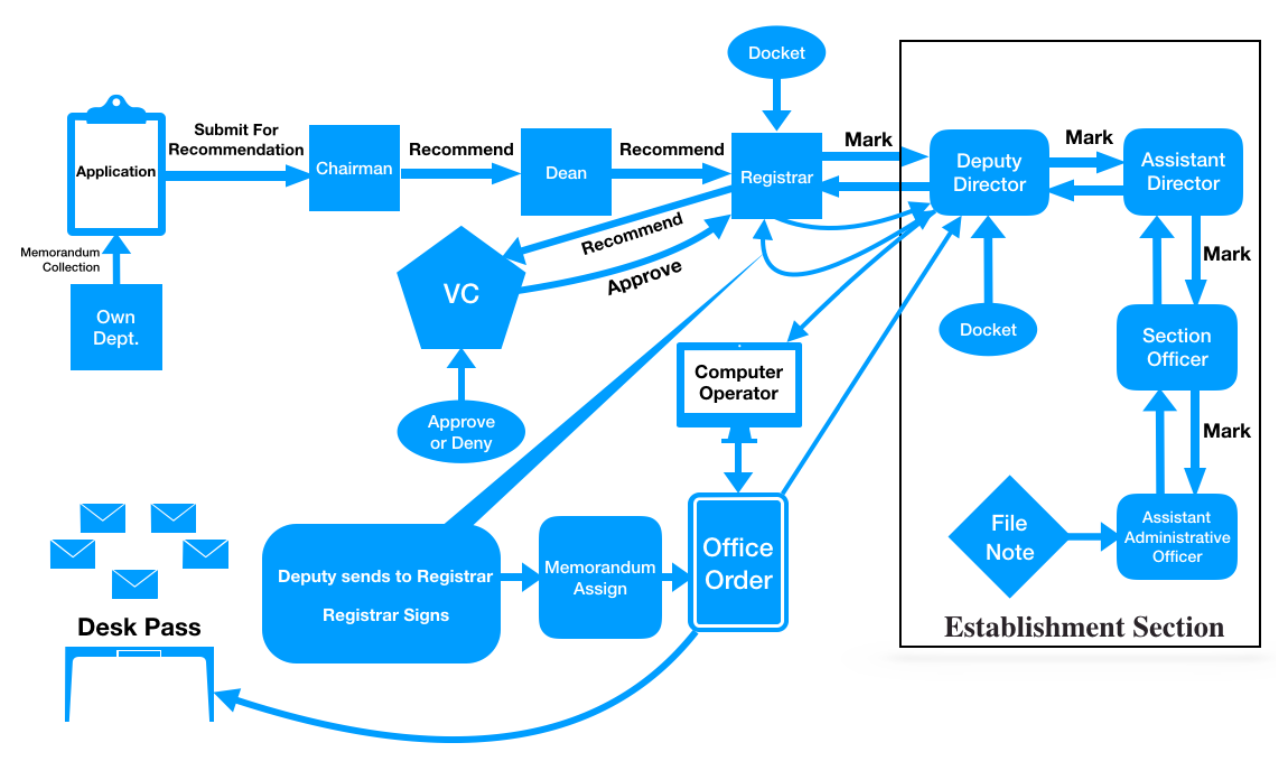
Software Mechanism:
We have developed different user interfaces for different users. Each interface is facilized with different functionalities. The main admin has a very unique functionality. From there he can add or set different administrative users. There administrative users are grouped in two types. They are:
1) Fixed Users: Vice Chancellor, Registrar, Dean Office In-charge
2) Multiple Users: Deputy Registrar, Assistant Registrar, Deputy Director, Assistant Director, Assistant Administrative Officer, Section Officer & Computer Operator.
The Fixed Users contains fixed user account for particular designations. On the other hand the Multiple Users may contain multiple user account for a particular designation.
When we login as the main admin, we will find an option called “add user” in the main administrative interface. By using that option the main admin can create or add a “Multiple Users” type user account. There the main admin has to give some information of the intendant user like name, description, email, contact number etc. Then a confirmation message with a account confirmation link will be sent to that email address of that user. The user will enter to that link, set his username and password to login and complete his profile. When the profile is completed, then the account is ready to use.
For creating account for “Fixed Users” type of users there is an option called Fixed Users. Creating users for fixed accounts is also done by using the same procedure.
Here is the output:

Any teacher of HSTU may go to the registration link, browse and select his name from the teachers list and give his email address to the particular field. If the given email address matches is email address provided on the HSTU Academic Database and if the teacher does not have any account on the system then an account confirmation email will be sent to the teacher’s email address. He will complete his account in the same procedure.
Here is the output:
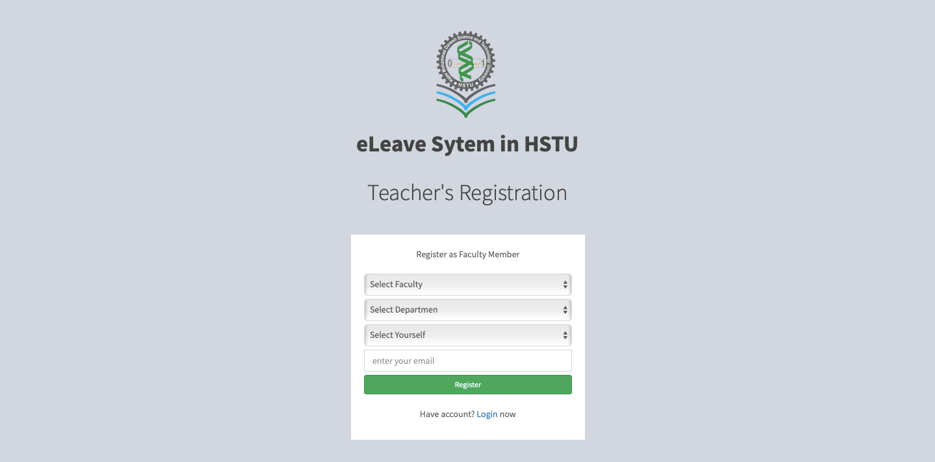
After completing teacher’s account, the teacher can login to his account. Then comes the teacher’s user interface. From there a teacher can write applications. Any application may be edited as many times as the teacher want before submitting that to the chairman. All applications will be stored as draft applications and from the list of the draft applications the teacher can submit any application to the chairman.
Here is the output of a teacher’s interface:

The interface of Dean and Chairman is basically the teacher’s interface with dean or chairman access. The system automatically detects if a teacher is dean or a chairman. The outputs are:
For Chairman:
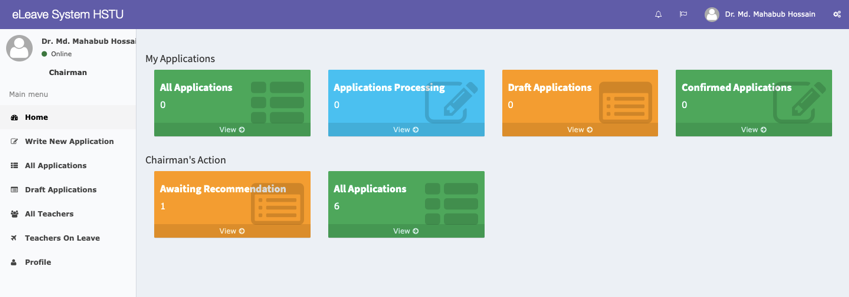
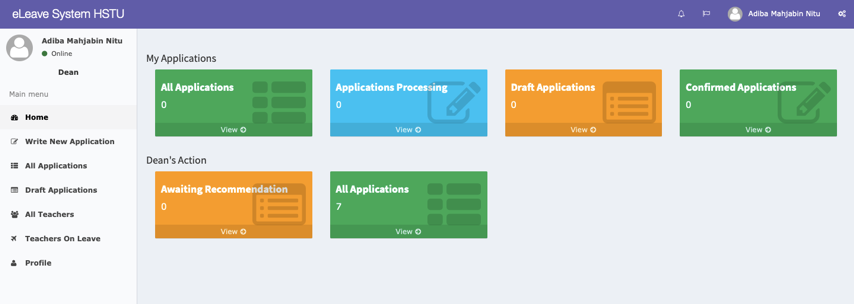
The application process starts from a user who need a leave for some purpose which is the teachers in our case.
At first, a teacher who need a leave will write an application. The application may contain necessary attachment and a departmental memorandum which is provided from departmental office. All applications are stored as draft application until they are submitted to the chairman. Any draft application can be edited as many times as the teacher wants.

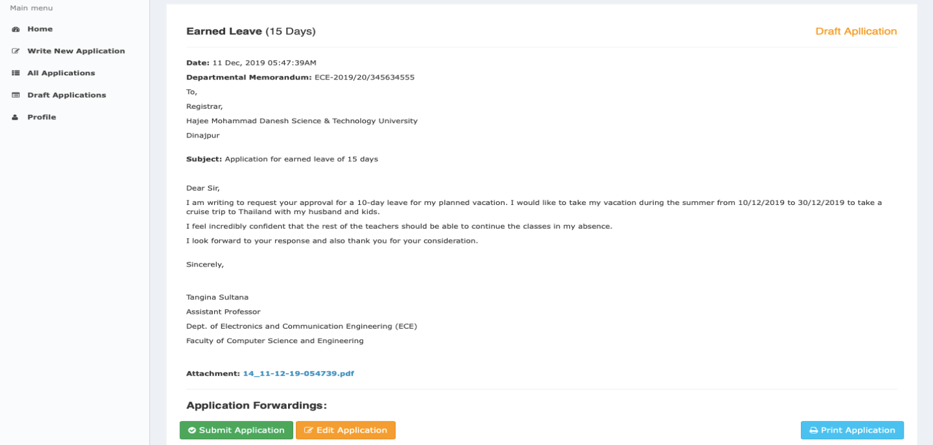
When a teacher submits an application, the application goes to the chairman. The chairman checks the application and forward it to the dean with his recommendation. As our software is linked with teacher’s database of the university so the software can easily collect the information on which teacher is currently in charge of chairman of that department. Then teacher is then automatically given the chairman’s privileges. If the chairman is changed then the new chairman will automatically get the chairman’s privileges.
The dean then checks the application and forward it to the registrar with his recommendation. The privileges assignment to a teacher for dean is also similar.
The registrar will then get the application. He will mark the application to a deputy director with his recommendation or comments. While forwarding, the registrar may docket the application and give the docket number to the application.
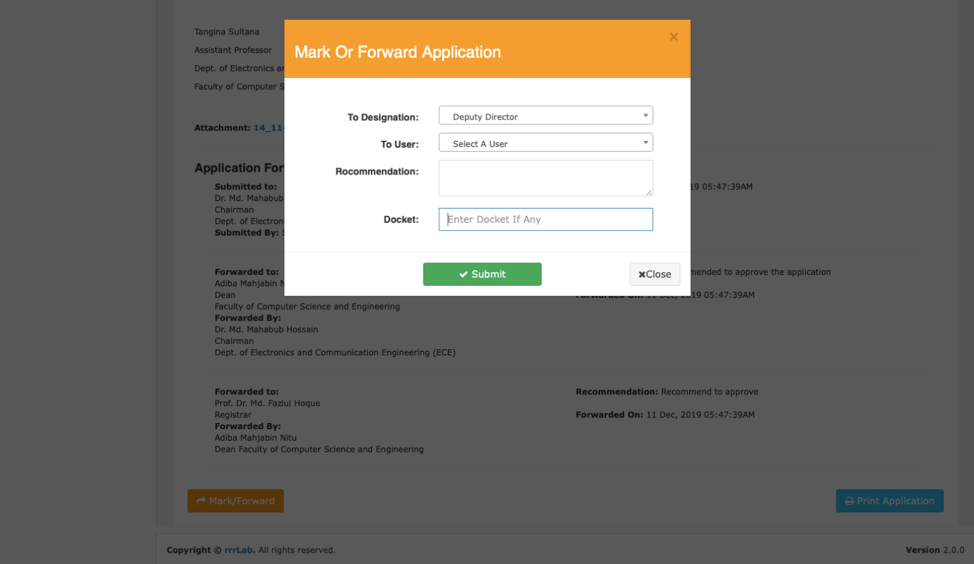
The deputy director then checks and marks the application to the assistant director.
The assistant director will also mark and forward the application to a section officer.
Then the section officer will mark and forward the application to assistant administrative officer for file note.
The Assistant Administrative Officer will give docket number and note it to the file.
Then the application will be forwarded back to the Section Officer by the Assistant Administrative Officer with recommendation.
The section officer will mark or forward back the application to the assistant director with his recommendation.
The assistant director will then mark or forward back the application to the deputy director with his recommendation.
Then deputy director mark or forward back the application to the registrar with his recommendation.
The registrar checks all the recommendations and forward the application to the Vice Chancellor (VC) with his recommendation.
The VC will approve or deny the application.
If the application is approved by the VC then it will be forwarded back to the Registrar. Then the registrar will mark the application to a deputy director for processing an office order.
The deputy director then forwards the application to computer operator for writing the office order. The computer operator has option to create office order. He will white the office order using the system and submit the office order to the Deputy Director.
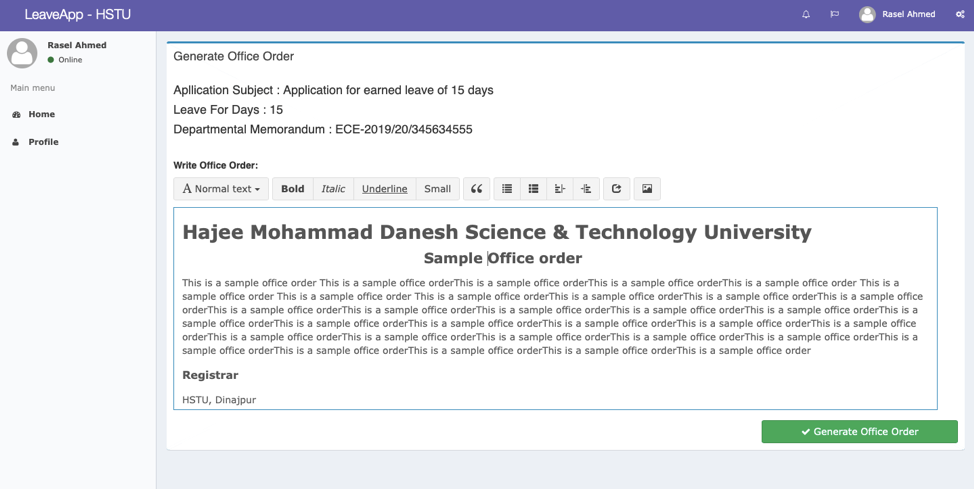
After generating the office order the Computer Operator will submit the office order and it will automatically be forwarded to the Deputy Director. The deputy director will assign a memorandum to the application and submit it to the Registrar for finalization. Finally the registrar will confirm application and thus the whole process will be completed.
After a leave application is approved and finalized, the teacher will be able to start his leave and the leave will be counted from the date of start. The leave will automatically expire after the days the teacher requested the leave for.
Here is the final state of a leave application after being finalized.
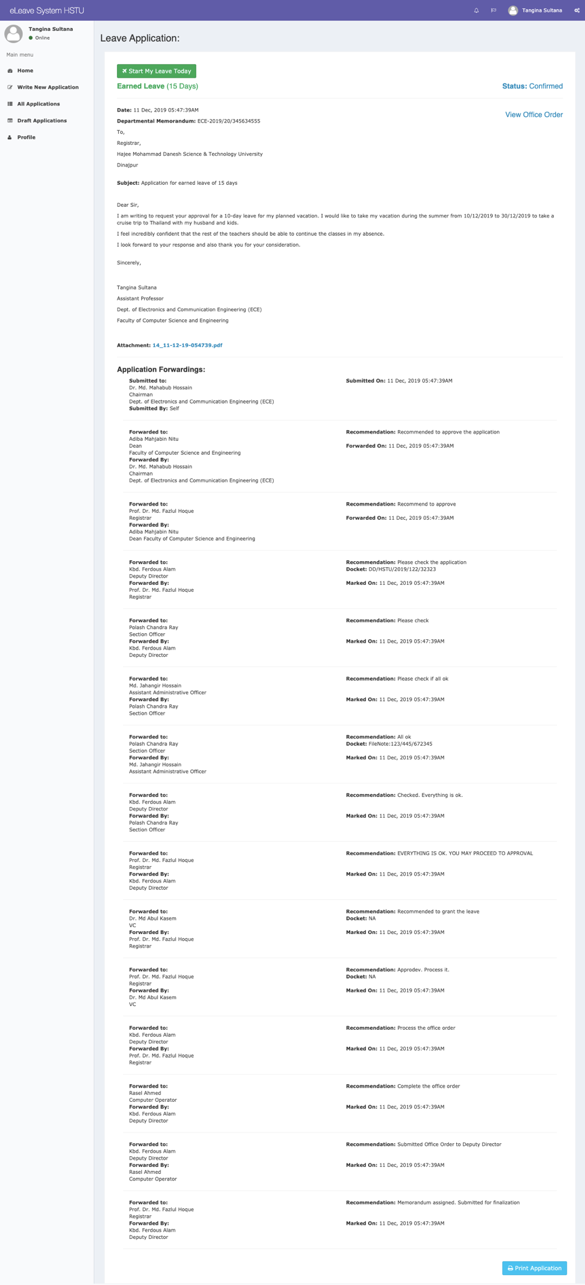
There is reporting system in our system which shows that which teachers are on leave, from when the teacher’s leave have started and on which date the leaves will expire. The registrar and the VC will be able to see the report for all the teachers. The dean will be able to see the report for all the teachers of his faculty and the chairman will be able to see the report for all the teachers of his department.

